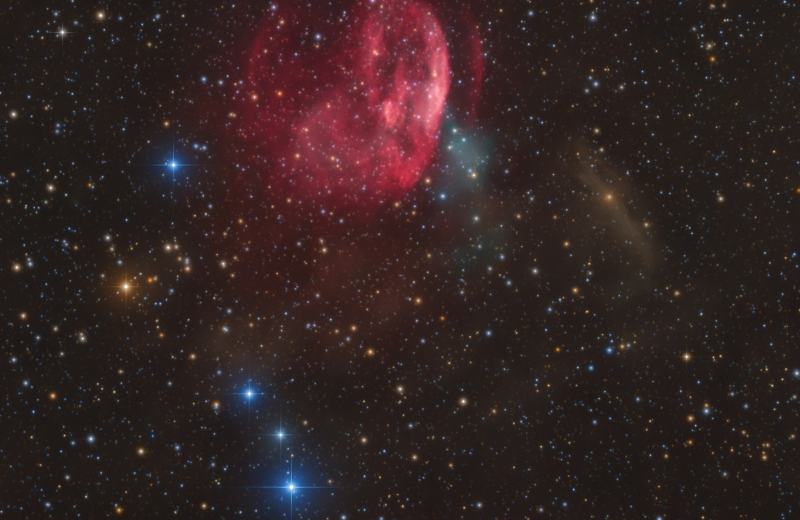Among the constellations of the night sky is Apus, a lesser-known but intriguing formation that represents the bird of paradise. Whether you’re an amateur stargazer, a student of astronomy, or just someone curious about the stars, learning about the Apus constellation can enrich your understanding of the sky. In this guide, we'll explore what makes Apus special, its mythological background, and how you can find it in the sky.
Jump to:
Recommended for you!
Best SellersWhat is the Apus Constellation?
The Apus constellation is one of the 88 modern constellations recognised by the International Astronomical Union. Located in the southern hemisphere, Apus represents the bird of paradise, a type of bird known for its vibrant plumage and elaborate courtship dances. The constellation is relatively small and faint, making it a bit of a challenge to spot, but its significance in the sky is no less interesting.
What Does Apus Look Like?

Apus isn’t one of the brightest constellations, so it doesn’t stand out as clearly as Orion or the Big Dipper. The constellation is composed of a few main stars that form an abstract shape, loosely resembling a bird. Although it might not be as striking at first glance, with a little practice and a clear night, you can begin to distinguish Apus among the stars.
The Apus Constellation Myth
Mythology plays a significant role in how constellations are named and understood. However, Apus doesn’t have the rich mythological background that some of the more famous constellations do, largely because it was named in the 16th century by European explorers. The name ‘Apus’ comes from the Greek word ‘apous’, meaning ‘footless’, which is a reference to the bird of paradise, known in early natural history for being footless because they were often depicted without feet in illustrations.
What is the Meaning of the Apus Constellation?

The Apus constellation symbolises the bird of paradise, a bird that was highly prized during the Age of Exploration. For early naturalists and explorers, the bird of paradise represented the exotic and unknown, a fitting symbol for a constellation located in the largely uncharted southern skies. The constellation reminds us of the sense of wonder and curiosity that drives exploration and discovery.
How to Pronounce Apus
You might wonder how to pronounce the word ‘Apus’. It’s pronounced as ‘AY-pus’, with the emphasis on the first syllable. It’s a simple and elegant name, fitting for a constellation representing such a graceful bird.
Apus's Stars
While Apus isn’t a constellation known for its bright stars, it does have a few notable ones. The brightest star in Apus is Alpha Apodis, which shines with a magnitude of about 3.8. Other stars in the constellation include Beta Apodis and Gamma Apodis, though they are fainter and may require a telescope or a clear night sky to see properly.
Nebulae in the Apus Constellation
Apus is home to some interesting deep-sky objects, including nebulae. A nebula is a vast cloud of gas and dust in space, often a region where new stars are being born. While the nebulae in Apus aren’t as famous as those in other constellations, they add to the richness of what you can observe within this small section of the sky.
Finding Apus in the Sky

Apus is a faint constellation located in the southern hemisphere, making it a bit of a challenge to spot, especially if you're not familiar with the night sky. The best time to observe Apus is during July and August, when it reaches its highest point in the sky. Unfortunately, for those in the northern hemisphere, Apus isn't visible, as it lies too far south.
Locating Apus
To find Apus, you’ll want to start by identifying more prominent constellations in the surrounding area. Apus is located near Triangulum Australe and Pavo, both of which can serve as helpful reference points. Triangulum Australe is a small but bright triangle-shaped constellation, and Pavo represents a peacock with a more distinctive pattern of stars.
Once you’ve identified these neighbouring constellations, you can use them to guide you to Apus. Although Apus doesn’t have any particularly bright stars, using a star map or an astronomy app can make locating it easier by providing a detailed guide to its position in the sky.
Viewing Apus with Binoculars or a Telescope
Given the faintness of Apus’s stars, using binoculars or a small telescope can greatly enhance your viewing experience.
- With Binoculars: Binoculars can help you see the faint stars that make up Apus more clearly, especially when light pollution or atmospheric conditions make them difficult to spot with the naked eye.
- With a Telescope: A small to medium telescope can give you a closer view of Apus’s stars. While the constellation doesn’t contain many deep-sky objects, a telescope can help you better appreciate the subtle details of its stars.
Special Features to Observe
Apus may not be as rich in bright stars or deep-sky objects as some other constellations, but it has its own unique features worth exploring:
- Alpha Apodis: This is the brightest star in the Apus constellation, though it’s still relatively faint compared to stars in other constellations. Observing Alpha Apodis through a telescope can provide a satisfying challenge for those interested in star hunting.
- Nebulae: Apus is home to some faint nebulae, which are clouds of gas and dust in space. While not easily visible without advanced equipment, knowing they’re there adds depth to your understanding of this part of the sky.
The Best Viewing Times
For the best chance of seeing Apus, aim to observe it during the southern hemisphere's winter months, specifically July and August. During this time, Apus will be higher in the sky, making it easier to spot. Make sure to find a location away from city lights, where the night sky is darker and the stars are more visible. Allow your eyes to adjust to the darkness for a better chance of seeing the faint stars that compose Apus.
Recommended for you!
Best SellersFun Facts About Apus
- A Relatively New Constellation: Unlike many of the constellations we know from ancient times, Apus was introduced in the late 16th century by Dutch navigators Petrus Plancius and Frederick de Houtman, based on the observations they made during their voyages.
- Size: Apus ranks 67th in size among the 88 modern constellations, covering an area of 206 square degrees.
- No Bright Stars: Apus doesn't have any stars brighter than magnitude 3.0, making it a relatively faint constellation that can be challenging to observe with the naked eye.
- Visibility: Apus is best seen from the southern hemisphere and is not visible at all from most of Europe and North America.
Study Astronomy for £29
If you’re fascinated by the stars and want to learn more about the universe, consider enrolling in our Astronomy Diploma Course at Centre of Excellence. You’ll gain a detailed understanding of the stars, planets, and celestial phenomena, all from the comfort of your own home. Sign up today for a discounted price of £29 and start your journey into the cosmos!













